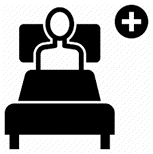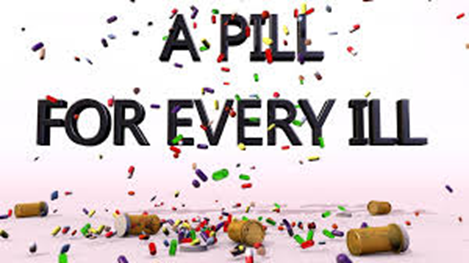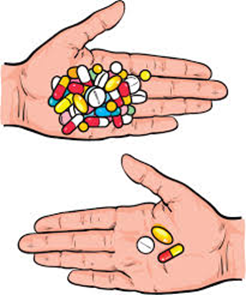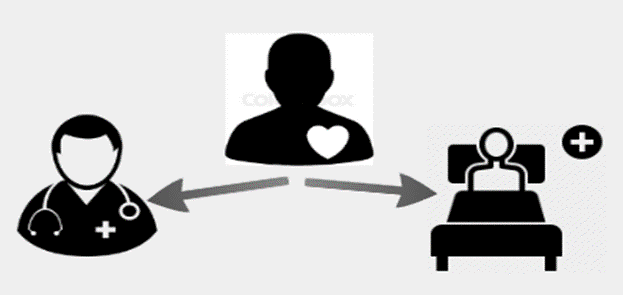Medication Overload
Medication Overload
Author: Mark Parkinson BsPharm: President AFC-CE
Credit Hours 2- Approximate time required: 120 min.
Educational Goal
Explain what Medication Overload is and ways that caregivers and reduce it’s negative effects on the residents.
Educational Objectives
- Define Polypharmacy, Medication Overload and the Pill Burden
- List contributing factors that cause medication overload
- Tell what is being done by medical profession to reduce medication overload
- Present idea about how caregivers can help manage the problem.
Procedure:
Read the course materials. 2. Click on exam portal [Take Exam]. 3. If you have not done so yet fill in Register form (username must be the name you want on your CE certificate). 4. Log in 5. Take exam. 6. Click on [Show Results] when done and follow the instructions that appear. 7. A score of 70% or better is considered passing and a Certificate of Completion will be generated for your records.
Disclaimer
The information presented in this activity is not meant to serve as a guideline for patient management. All procedures, medications, or other courses of diagnosis or treatment discussed or suggested in this article should not be used by care providers without evaluation of their patients’ Doctor. Some conditions and possible contraindications may be of concern. All applicable manufacturers’ product information should be reviewed before use. The author and publisher of this continuing education program have made all reasonable efforts to ensure that all information contained herein is accurate in accordance with the latest available scientific knowledge at the time of acceptance for publication. Nutritional products discussed are not intended for the diagnosis, treatment, cure, or prevention of any disease.
Medication Overload
Three times in one year, a normally clear-thinking elderly woman was found wandering the neighborhood with her dog, unable to find her way back home. Upon review of her medication use, it was discovered that she had three different PRN (or, as-needed) medications for pain and anxiety. When all three were taken together, her ability to think clearly was so impaired that she would attempt to get into other people’s homes, thinking they were her own.
The adverse effects that arise from polypharmacy has been described as “America’s other drug problem.” Polypharmacy is loosely defined as the taking of at least five different medications together. As more and more drugs are prescribed to manage medical complaints, the chances of unforeseen side effects increase.
Iatrogenesis, or doctor-caused harm, is a perplexing problem that has always been associated with the prescribing of multiple medications together. Doctors find it hard to predict what side effects will arise when normally beneficial medications are taken together. Ironically, many doctors will prescribe even more medications to manage this “drug-caused” problem. What has been described as the “drug cascade” is an old problem of polypharmacy that is receiving new efforts to manage.
 Not all polypharmacy is bad. There are certain disease states, like diabetes and mental health issues, where a multi-drug regime is required to manage the medical condition. To differentiate from those situations, a new term has been developed: medication overload. Medication overload is defined as the use of multiple medications for which the harm to the patient outweighs the benefit.
Not all polypharmacy is bad. There are certain disease states, like diabetes and mental health issues, where a multi-drug regime is required to manage the medical condition. To differentiate from those situations, a new term has been developed: medication overload. Medication overload is defined as the use of multiple medications for which the harm to the patient outweighs the benefit.
Harm to the patient can be more than just a biological side effect. Taking multiple medications can create a significant financial, emotional, and time burden for the patient to manage. Taken together, all these problems are known, in many medical publications, as the pill burden. A significant pill burden can greatly reduce the overall quality of life for a patient. As a practicing pharmacist, I witnessed firsthand the pill burden that many of my customers faced. It was heartbreaking to watch them struggle to decide whether to buy food or fill their prescriptions.
Major health institutions and medical associations are starting to recognize the problems of medication overload. They are beginning to take steps to try to understand the causes of iatrogenesis and reduce the pill burden their patients are experiencing. As with any scientific endeavor, the first step these organizations are taking is the gathering of data.
The Lown Institute of Canada reports that “Every day, 750 older people living in the United States (age 65 and older) are hospitalized due to serious side effects from one or more medications. Over the last decade, older people sought medical treatment more than 35 million times for adverse drug events, and there were more than 2 million hospital admissions.” Source: Medication Overload and Older Americans,” Lown Institute.
In the same article, it was also reported that polypharmacy “has reached epidemic proportions. More than four in ten older adults take five or more prescription medications a day, tripling over the past two decades. Nearly 20 percent take ten drugs or more.” Similar data has also been reported in mental health and developmentally disabled patients who have multiple heath problems.
Why has this occurred?
No one in the medical field wants to cause the patient harm. Yet, for multiple reasons, harm is being experienced. To better manage the problem, a greater understanding of the causes must be considered. The many contributing factors can be more fully comprehended by placing them in three broad categories.
The Culture of Prescribing
The “a pill for every ill” culture of our modern society has it roots in several factors:
- Pharmaceutical companies seeking profits. In order to stay in business, drug companies must sell products. They rely on salesmen that try to influence prescribers, and they advertise with slick commercials to try to influence consumers.
- Overworked medical professionals. To treat all their patients in a profitable way, prescribers must be very efficient with how much time is spent with each patient. It is by far easier and quicker to write a prescription than manage a disease. “Take two pills and call me in the morning” is an easily recognized phrase.
- The add-on therapy. Many treatment regimes call for adding drugs to therapy until the symptom is controlled. This leads to multiple drugs, all treating the same symptom. Doctors are trained to add a drug instead of replacing a drug.
- Demanding patients. Patients, their families, and their caregivers often demand that the doctor “do something.”
 The perception of treatment is often linked to taking a drug.
The perception of treatment is often linked to taking a drug.
- Consumer culture. Consumers are used to buying their way out of problems. Have long grass, buy a lawnmower. Need food cooked quickly, buy a microwave. Have constipation, buy a laxative pill. The consumer finds it easier buy a drug to manage a medical problem than make changes to their lifestyle.
- The vast majority of health-care costs are paid for by insurance companies. Health care is expensive. Insurance companies must impose limits on what they pay for or they will go out of business. They will try to save money by paying for older, cheaper medications that have more side effects and are more complicated to use than newer, expensive ones.
Information & Knowledge Gaps
The more medications that are consumed, the more information and knowledge is required by the prescriber and the patient. Yet when harm is caused, it is a clear indication that information was lacking.
- Drug Companies: Pharmaceutical manufacturers cannot study the effect of combining their drug with every other drug or combination of drugs. It is an unknown and unknowable hazard factor in prescribing medication. Doctors are forced into prescribing blind to the consequences of combining medication.
- Prescribers: Doctors are often unaware of the full list of the drugs the patient is taking. Doctors also lack reliable information on non-drug therapies. Therapy outcomes research is expensive and drug companies are often the only ones willing to pay for the research. Doctors are more willing to go with a proven drug therapy than experiment with an unproven non-drug therapy. Critical feedback from the patient about drug therapy outcomes is also dangerously lacking. If the patient does not call the doctor, the prescriber assumes that everything is okay.
- Patients: The person receiving the drug is given instructions and written material about how to manage its use. But how often is that material read, and the instructions understood? The more pills that are taken, the greater amount of material there is to read. The little old lady who takes 1o different pills will not be able to appropriately manage all of them, especially when there are several medications that cause a drugged haze to her thinking. To complicate drug management even further, she may also use several health supplements and over-the-counter (OTC) medications that do not come with any medication literature to help her understand her medications.
Fragmentation of Care
The more advanced our medical knowledge becomes, the more specialized its practitioners become. You have cancer specialists, gerontologists, urologists, nurse practitioners, physician assistants, psychiatrists, and all the other “–ists” who have the ability to write prescriptions. Each has the same pressure to “do something.” Yet who is being held responsible to coordinate all these efforts? The primary care doctor (if there is one), the patient (who has no medical background), or the caregiver (who has no authority)? The coordination of American-style medicine and communication between its practitioners is lacking in many ways. Often, a “prescription cascade” occurs when one doctor will prescribe a medication that causes a side effect. Another doctor will prescribe an additional drug to manage the side effect, and around and around it goes until there is a significant medication overload.
Case in point, as reported by the Lown Institute:
“Killed by a Prescription Cascade
How did Joe Esposito go from a man in remarkable health, effortlessly running half marathons in his 50s, to being debilitated and incapacitated, struggling at death’s door, in just a few years? When Joe sought treatment for his mild to moderate Crohn’s disease, his list of medications cascaded from one to six to twenty, as each new medication brought on a new side effect. The steroids he was prescribed to treat Crohn’s led to bone loss and anal fistulas. He was given antibiotics for the fistulas, which caused peripheral neuropathy in his feet. He couldn’t sleep from the pain so he was prescribed benzodiazepines and Ambien for sleep, Lyrica for the nerve damage, and Tramadol for the pain. Several of the drugs gave him severe diarrhea. To treat his diarrhea, he was given opium drops, and other medications. Additional drugs weakened his kidneys, which in turn raised his blood pressure, so he was put on four blood pressure medications. And an experimental anti-inflammatory drug led to Joe contracting pericardial tuberculosis, which almost killed him.
At the end of his life, Joe was taking over 20 medications and 31 pills a day, but not one physician saw this as a problem worth addressing or even considered that his symptoms were caused by the drugs and not the Crohn’s disease.”
No one doctor can solve this problem. The training and tools are lacking. Medical societies and organizations are trying to step up to the plate and help manage medication overload. They are promoting new medical paradigms to counter the “pill for every ill” culture we live in.
Integrated Medical Records
In the past, prescribers kept their own records that other prescribers did not have easy access to. Larger health systems like Kaiser Permanente and the University of Utah now have medical record systems that are available via a shared computer system to everyone who has a need to know. Any prescriber, nurse, therapist, or pharmacist can see what the other clinicians are doing. In addition, since patient histories and lab values are readily available to other medical personnel, some of the more mundane doctor tasks are being done by other staff. This frees up prescribers to have more time with their patients.
Medication Management Services
Medical specialists are providing services that assist the doctor and patient in managing their medications. For example, diabetic educators and pharmacists actively work with patients to review all their medications, monitor outcomes, and report to the doctor any significant events and recommendations.
MTM – Medication Therapy Management is a program of several services provided to assist the doctor and patient and help them get the most out of drug therapy. Those services include:
- A review of all medications prescribed by all prescribers providing care to the patient, and any over-the-counter and herbal products the patient may be taking to identify and address medication problems. Problems may include medications not being used correctly, duplication of medications, unnecessary medications, and the need for medication(s) for an untreated or inappropriately managed condition.
- In-depth, medication-related education, consultation, and advice provided to patients, family, and/or caregivers to help assure proper use of medications.
- Collaboration with the patient, physician, and other health-care providers to develop and achieve optimal goals of medication therapy.
Deprescribing
Deprescribing is the planned and supervised process of dose reduction or stoppage of medication that might be causing harm or is no longer of benefit. To encourage prescribers to incorporate deprescribing in their practice:
- Deprescribing principles are being included in doctor education and continuing education courses
- Research is being done to provide evidence-based protocols
- Computer tools and practice protocols that assist in deprescribing are being made available to prescribers.
What can in-home caregivers do?
In-home caregivers are in a unique position. They are both part of the professional health-care team and can act as an advocate of the patient. This makes caregivers particularly suited to deal with medication overload problems. They can ensure drug therapy is followed and push for changing the therapy when it needs to be changed. Even if the patient is already part of an MTM program, there are still many things a caregiver can do to reduce the ill effects of medication overload.
Monitor and Report
- Foster caregivers can ensure there is always a complete and up-to-date list of all the medications and supplements available for all medication prescribers to see. This simple action alone results in huge benefits. Prescribers will finally have a sure knowledge of what medications the patient is actually taking. It will also help prevent the fragmentation of medical care.
- Caregivers can observe and report how the patient is reacting to therapy in a timely fashion.
-
- Side effects can be reported as they occur, not months down the road at the next scheduled doctor’s appointment. This will make it easier to determine that new symptoms are actually drug side effects and not a worsening of the disease state.
-
- PRN logs can be supplied to the doctor telling him or her exactly how much of drug is being taken and when. It will allow the doctor to see patterns of drug use that will help determine when therapies need to be changed.
Advocate and Action
Caregivers can act as the representative of the doctor and the resident, and can work to support the interests of both.
 Caregivers representing the doctor:
Caregivers representing the doctor:
- You can support lifestyle changes so that the doctor does not have to rely on drugs for needed therapeutic effects.
- You can guarantee the patient is not overtaking their medications.
- You can control unauthorized over-the-counter medications and supplements.
- You can stop the use of alcohol, tobacco, and other substances that can interfere with therapy.
- You can control the overuse of PRN medications, ensuring they are used only when needed, not just when they are wanted.
- You can help the patient understand their therapies better.
- You will enforce doctor’s orders and ensure therapies are remembered and followed.
Ensuring the resident understands and remembers their medication instructions is a very important part of drug therapy. The lack of understanding and the failure to remember are major causes of medication overload. A study done in Italy in 2014 demonstrated how big this problem is. It looked at 100 patients (65 years of age or older) discharged from an internal medicine ward throughout 2012. The patients were followed for three months after discharge. The study found:
- Non-adherence was reported to be 55.1% at first follow-up and 69.6% at three months.
- Only 28.1% at first follow-up and 25.3% at second understood the reason for their medication.
When therapy is not followed, symptoms will continue. This leads to patients complaining to the doctor, demanding they “do something.” This leads to more medications being added, and the drug list grows and grows.
 Caregivers representing the resident:
Caregivers representing the resident:
- You can request actions that need to be taken.
- You can challenge questionable medical decisions.
- You can ask the questions that will make the clinician rethink his or her interpretation of why symptoms are occurring and thus reduce over-prescribing to control new symptoms.
- You can prevent family and friends from interfering with therapy.
Consider the following case.
Mrs. A was a 71-year-old widow with congestive cardiac failure and osteoarthritis. She was put on digoxin to help her heart function normally. Later, furosemide (a water pill) was added to reduce the amount of fluid that was building up. The daughter noticed over a two- to three-month period that her mother was becoming confused, easily fatigued, and very irritable. She also noticed that her mother had become compulsive about washing her curtains. Mrs. A said they always looked yellow-green and possibly moldy. The daughter, not knowing what was going on, assumed her mother was getting dementia and contemplated putting her in a nursing home. Fortunately, someone started asking what effect adding the furosemide had on Mrs. A’s symptoms. It turned out furosemide can cause digoxin poisoning, The poisoning caused confusion, irregular pulse, nausea, and a fast heartbeat. Mrs. A felt miserable and became irritable more often. Tellingly, digoxin poisoning can create vision changes. Mrs. A always saw her curtains as yellow and green, no matter how often she cleaned them.
Too bad there wasn’t a foster caregiver there to start asking the right questions earlier.
Medication Overload Action Steps for Caregivers
 Caregivers have been working to prevent medication overload for decades. We just didn’t know what our efforts were called. All of us have, to one extent or another, been trying to control medications, promote healthy lifestyles, and fight with doctors over what is best for our residents.
Caregivers have been working to prevent medication overload for decades. We just didn’t know what our efforts were called. All of us have, to one extent or another, been trying to control medications, promote healthy lifestyles, and fight with doctors over what is best for our residents.
To help make your efforts more effective, I recommend the following action steps. I do not intend this to be a step-by-step system that has to be followed in order to be effective. Rather, I present these action steps as suggestions to augment what you are currently doing.
New resident’s drug and supplement evaluation
When a new resident moves into your home, gather all their drugs (prescription and OTC) and supplements. Compile a list for the primary care physician to review. Look for the following information and make notes on the drug list you’re going to give to the doctor. The information will be very important, and it may be the first time that the doctor has seen it.
- Write down the medication name, strength, instructions, and who prescribed it.
- Note the expiration date of the drug. If it is expired, set it aside and don’t dispense it. Write on your list that the drug is expired, and ask the doctor if he wants to continue the drug.
- Ask the resident why they think they are taking the drug.
- Find out how often and when the resident last took each PRN drug.
- Do all of the above for each OTC drug and supplement. Do not dispense these until the doctor gives you permission through a prescription.
- After you compile your list, get it to the doctor. Follow up with the doctor until YOU are satisfied with the outcome. Don’t be afraid to act as the resident’s advocate. Politely push the doctor along and keep asking questions until you get results. If a doctor discontinues a drug or supplement, place a note about the order in the resident’s file. Pass the word on to the family so they will not try to give the discontinued drug to the resident.
Med list in resident’s file
After you get an “approved” drug list from the doctor, add the list to the resident’s file and make sure it goes with the resident to every medically related trip the resident takes. That includes therapy visits.
New order evaluation
Do not just accept a new prescription or therapy order. Find out the why’s and the what’s.
- Why is the drug or therapy being prescribed?
- What is the goal(s) of the therapy?
- What are the key indicators to monitor for?
- How often does the doctor want a report on outcomes?
Report to the doctor what you have observed.
- Read the drug literature. Note the side effects and monitor closely for at least a month. You will be the first to notice any adverse reactions. You need to report them in a timely fashion. Reporting side effects can happen only if you’re looking for them.
- Timely reporting will greatly help the doctor determine if a new or worsening symptom is drug-related or disease-related.
- Don’t be afraid to challenge the need for a new prescription—especially if side effects start to occur or therapeutic goals are not being achieved.
Old order evaluation
Do not be afraid to ask questions about any drug or therapy order. Doctors have had plenty of training on how to prescribe a drug but little to no training on how to deprescribe a drug. I find the prevailing course of action in medical practice is to add a drug and just leave it there until it is forced off the list by an adverse event. Often, I find that the only person willing to ask the challenging questions surrounding the need for a drug is the caregiver.
Keep an eye on these drugs
Pay close attention to the following drugs:
|
Drug/Drug Class |
Reason to pay attention |
|
Digoxin |
Digoxin poisoning can be caused by other drugs. |
|
Blood thinners – Warfarin, Heparin |
Interaction with drugs, supplements, and even food can cause excessive bleeding and bruising. |
|
Antidepressants – Fluoxetine, Amitriptyline, Doxepin, Trazodone, Citalopram, Sertraline |
Serotonin Syndrome: slurred speech, confusion, falls. Changes in behavior. Just not needed in the stable, supportive environment of a care home. |
|
Antianxiety/Sedatives – Lorazepam, Ativan, Diazepam, Zolpidem, Diphenhydramine, Haloperidol
|
Slurred speech, dizziness, falls, confusion. Changes in behavior. Just not needed in the stable supportive, environment of a care home. |
|
Painkillers – NSAIDS, Aspirin, Opioids, Narcotics |
Can cause drowsiness, confusion, falls, constipation, nausea. Can interfere with other meds. |
|
Protein-Pump Inhibitors (PPIs) – Omeprazole, Lansoprazole, Pantoprazole
|
Just not needed for long-term therapy. |
|
Nerve Pain/Antiseizure – Gabapentin, Lamotrigine Phenytoin, Carbamazepine, Phenobarbital |
Slurred speech, dizziness, falls, confusion, changes in behavior. |
Manage the drugs
Foster care providers are not idle followers of other medical professionals’ orders. They are active participants in drug therapy management. The doctors may be the generals who give the orders, but you are the soldiers who actually turn those orders into actions. When those orders don’t fit neatly into the reality of the situation, you can push for a modification of those orders.
- Change to a PRN. Drugs don’t always have to be given around-the-clock in order to achieve a therapeutic goal. There are those drugs that could be changed to PRNs as long as you are educated on what circumstances they need to be dispensed under.
- Monitor the patient. Keep track of your resident’s condition. If therapy goals are not being achieved, ask why the drug is still being prescribed. Before reporting a new symptom, first look at the side-effect profile of the resident’s meds for possible causes. Point out these “possibilities” to the doctor and let him figure out what is actually going on.
- Multiple meds of the same drug class. If you see two antidepressants, two diabetic drugs, two statins, or multiples of any drug class, I would consider that justification to ask why. Are both really needed? Does the marginal benefit outweigh the possible side effects?
- Discontinue a drug no longer needed.
- If the drug was needed to prevent a condition that you now manage with lifestyle changes, is the drug still needed? Examples: Are stool softeners still needed if you are controlling constipation through proper diet? Are antianxiety meds needed around-the-clock if you are keeping the resident calm through good caregiving?
-
- If conditions have changed, is the drug need still there? Examples: Does an 85-year-old woman still need to take estrogen? Does a 90-year-old man still need to take anti-cholesterol statin drugs?
-
- Make sure there is a need before a PRN pill is dispensed. I know it can be tricky to tell the difference between a perceived need and an actual need. Paying attention to how a resident reacts after taking the med will give important clues. For example, haloperidol (Haldol) taken for anxiety takes up to four hours to take effect. If the resident calms down after a few minutes, the calming effect did not come from the drug.
- PRN logs as red flags. Medical concerns can be seen first in an increased use of PRN meds. Report sudden increases in PRN use to the doctor and ask the doctor if it is a sign of therapy failure or medication overload.
- Take advantage of the pharmacists and visiting nurses. Sometimes changes can be made faster and more easily if the request comes from a pharmacist or nurse. Also, pharmacists are easily accessible drug encyclopedias. If you have questions or concerns over anything drug-related, run them by the pharmacist first—especially if a pharmacist is doing an MTM review in your home.
- Use the terminology to make the point. I found that, as a caregiver, nothing gets a doctor’s attention faster than using proper medical terminology. Try it next time you communicate with the doctor and take note of their reactions.
Here are two more case studies that illustrate the need for active medication management by the caregiver.
CASE 1
A 39-year-old white woman with depression and panic attacks was being treated with fluoxetine, trazodone, clonazepam, and cimetidine. After fluoxetine and clonazepam were abruptly discontinued, venlafaxine and lorazepam were started. Within 24 hours, she developed diaphoresis, tremors, slurred speech, myoclonus, restlessness, impaired thinking, and diarrhea. These are all symptoms of drug-caused serotonin syndrome.
Case 2
An 83-year-old woman was taking 17 different medications. She started to show new signs of tremors, slurred speech, ataxia, and depression. Her symptoms started to manifest themselves after a recent stay in the hospital and the addition of several new medications.
When the pill burden and the side effects of medications outweigh their benefits, a medication overload condition exists. Foster caregivers are in a powerful position to start to manage and reduce this harmful effect of polypharmacy. For the good of the resident, caregivers need to actively monitor the drug effects, manage the drugs, and push for changes when needed.
As always, good luck in your caregiving.
Mark Parkinson, BS Pharm
References:
Medication overload and older Americans. Lown Institute, 2020
Angie Eaton, PharmD, Polypharmacy in the Elderly. https://media.bcm.edu/documents/2015/c9/igcesession021815.pdf
Alice Bonner. How to Address the Harm of Medication Overload. Institute for Health Care Improvement. Feb 20, 2020.
http://www.ihi.org/communities/blogs/how-to-address-the-harm-of-medication-overload
Maria G. Tanzi. Eliminating medication overload. Pharmacy Today, Volume 26, Issue 4, P20-21, Apr 01, 2020
https://www.pharmacytoday.org/article/S1042-0991(20)30297-8/fulltext
Tackling Medication Overload. Aging 2.0. Sep 24, 2019 https://www.aging2.com/events/details/aging-20-baltimore-presents-tackling-medication-overload/
What is Deprescribing?. Deprescribing.org. 2020 https://deprescribing.org/what-is-deprescribing/
Wade Thompson, HBSc, Barbara Farrell, BScPhm, PharmD, FCSHP, Deprescribing: What Is It and What Does the Evidence Tell Us?. Can J Hosp Pharm. 2013 May-Jun; 66(3): 201–202., doi: 10.4212/cjhp.v66i3.126. PMCID: PMC3694945. PMID: 23814291 https://www.ncbi.nlm.nih.gov/pmc/articles/PMC3694945/
Michael Steinman, MDEmily Reeve, BPharm(Hons) PhD. Deprescribing. Up To Date, Jan 21, 2020. https://www.uptodate.com/contents/deprescribing
Exam Portal
click on [Take Exam]
Purchase membership here to unlock Exam Portal.
|
|
|
|
|
*Important*
Registration and login is required to place your name on your CE Certificates and access your certificate history.
Username MUST be how you want your name on your CE Certificate.












